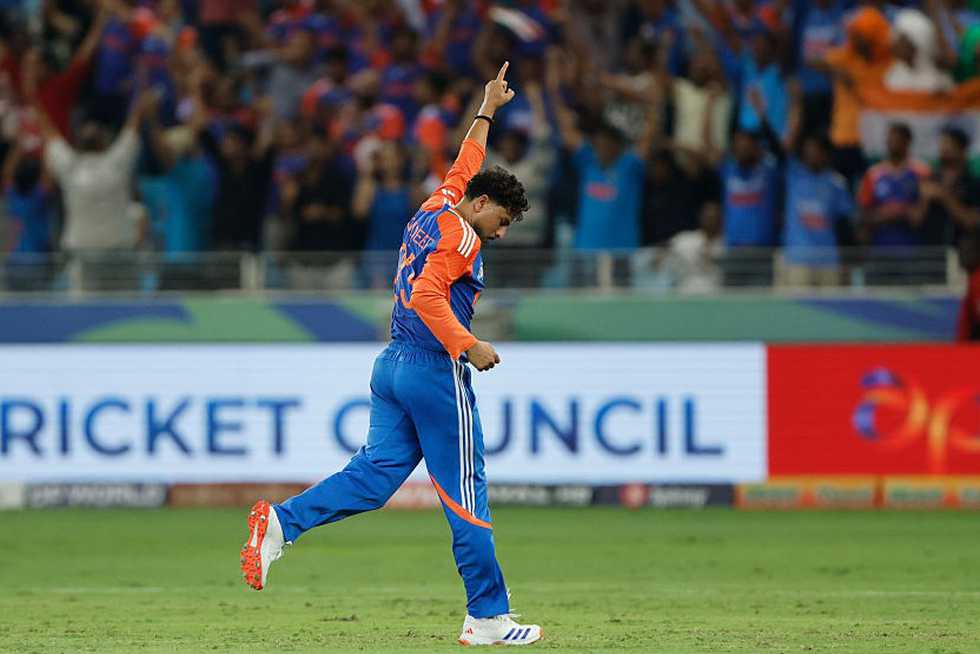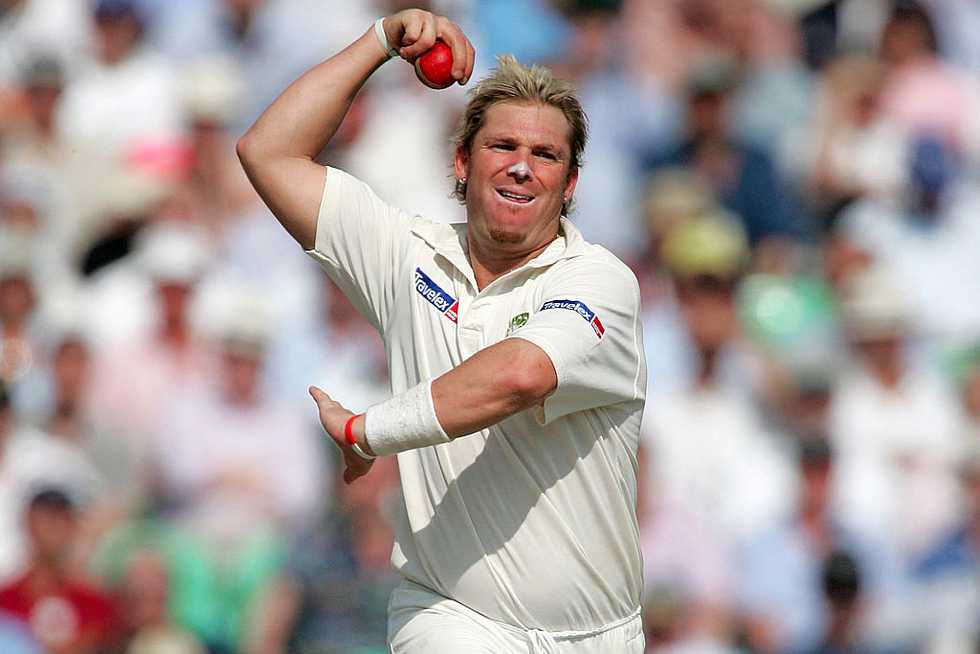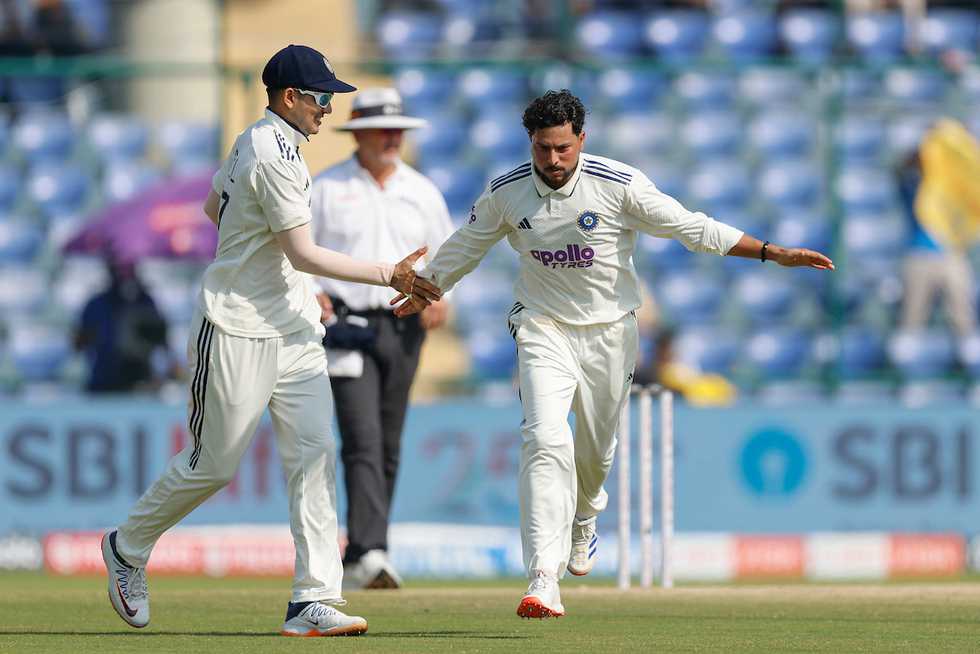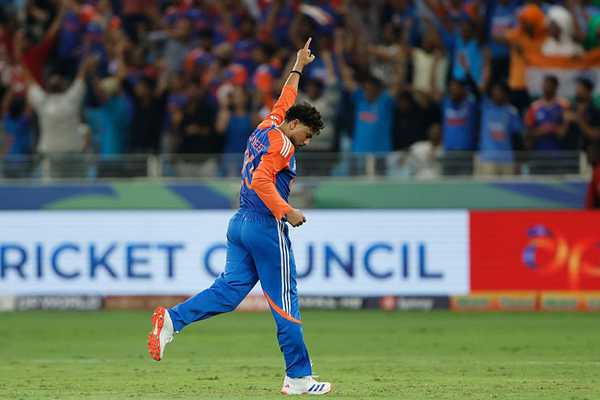
Kuldeep Yadav was outstanding in India’s Asia Cup win. ©Getty
They may be played with the same willow and leather under largely the same set of rules, but Test cricket and T20 cricket have evolved into fundamentally different sports. While a few exceptional players have made skills transferable – like a David Warner or Yashasvi Jaiswal bringing their attacking instincts to the red-ball game, or a Jasprit Bumrah or Josh Hazlewood exporting their skills and accuracy to T20 bowling – these players remain exceptions to the rule.
This divergence is most pronounced in the unforgiving art of wrist spin, where few bowlers have managed to maintain simultaneous, let alone sustained effectiveness in both the longest and shortest formats. Yet there is growing evidence to support the idea that one wrist spinner in the modern game stands head and shoulders above the rest in this field.
Test cricket and its frosty relationship with wrist spin
The history of Test cricket shows a cautious relationship with wrist spin, largely due to the inherently risky nature of the art. Of 121 bowlers with 150+ wickets in Test cricket, a mere 10 are wrist spinners (right and left arm combined) – the fewest among all bowling types. Being a difficult skill to master, it takes the cream of talent to reach top-flight cricket and once they get there, the skill often demands a higher tolerance for error from the team management.
Teams have historically viewed wrist spinners as an attacking luxury, given their high-risk, high-reward nature. This is an antithesis to the foundation of Test match bowling, which is built on the principle of bowling an accurate channel repeatedly, eventually forcing the batter into a misjudgment. The contortion of the body required to maximize revolutions and project the ball from the back of the hand makes wrist spin an incredibly tough art to practice, let alone bowl sustained spells with pin-point accuracy.
Shane Warne is undisputably the greatest wrist spinner of all time, and played a massive role in bringing the skill to the mainstream. Unsurprisingly, five of the 10 wrist spinners with 150+ scalps played the majority of their career during the Warne era (1992-2007), a period that accounted for about a third of the total wickets bagged by wrist spinners in the history of the format. Since Warne’s last appearance, however, only two wrist spinners have picked up north of 100 wickets in Tests: Yasir Shah (244) and Devendra Bishoo (117). In fact, wrist spinners aggregated fewer wickets than any other type of bowling in the post-Warne era.
The T20-era bred wrist spinner
Warne’s retirement coincided with the proliferation of T20 cricket, marked by the inception of the IPL in 2008. The first decade of T20 International cricket (2003-2010) saw wrist spinners playing a peripheral role. Shahid Afridi was the highest wicket-taker among them, but he alone sent down nearly half of all wrist-spin deliveries and was the only one in the top 40 wicket-takers.
Spinners slowly became more prominent in the following half-decade, initially favouring mystery spinners. However, with the ICC cracking down on illegal actions around 2015, teams globally began to resort to wrist spin. The ability of wrist spinners to deviate the ball in either direction became an invaluable asset against hard-hitting batters.
This gave rise to a new crop of wrist spinners. Unlike the conventional wrist spinner who prioritized flight to bring the outside edge into play (such as a leg spinner bowling to right-handed batters), the T20-era bred spinner specialised in bowling flatter, faster, into the wicket, and hurrying the batters, often aiming to cramp them for room and beat the inside edge. Shahid Afridi, though from an earlier generation, was in many ways a prototype for this kind of attack.
Finding success across formats
The 2015-2016 period proved to be a watershed for wrist spinners in white-ball cricket. The four leading wicket-takers in ODIs post the 2015 World Cup were all wrist spinners. To put this in perspective, Shahid Afridi was the only wrist spinner in the top 30 wicket-takers in ODIs during the three World Cup cycles between Warne’s last ODI appearance in 2003 and 2015.
While Warne himself tasted success in his maiden T20 assignment with the Rajasthan Royals in the 2008 IPL, the conventional leg-spinner largely struggled in the shortest format. Conversely, while the new-age wrist spinners became household names in the T20 circuit, hardly anyone could transfer those skills effectively to Test match cricket.

Shane Warne: The Gold standard for wrist spin. ©Getty
It is particularly telling that neither Yasir Shah nor Devendra Bishoo – the two post-Warne wrist spinners with 100+ Test wickets – had any significant white-ball career. Yasir has played only 25 ODIs and two T20Is, and his PSL appearances are limited to 27 caps, with none since 2021. Likewise, Bishoo played 42 ODIs, only a handful of T20Is for the West Indies (7), and made the playing XI only 12 times across the CPL. The skills required for sustained success at the highest level of Test and T20 cricket for a wrist spinner appear to be mutually exclusive for all but the rarest talents.
The profound divergence between Test and T20 cricket has made simultaneous, sustained success for wrist spinners a rare feat. In the first two-and-a-bit decades of the formats’ co-existence, only four wrist spinners have managed to pick up 50+ wickets across all three International formats. Of this exclusive group, two – Imran Tahir and Adil Rashid – have prioritised white-ball cricket, effectively ending their Test careers. The third, Ish Sodhi, remains sporadic in his Test appearances – just 21 caps in 13 years.
Wrist spinners with 50+ wickets in each of the three formats
Bowler Wkts Tests ODIs T20Is Adil Rashid 433 60 232 141 Kuldeep Yadav 335 68 181 86 Imran Tahir 293 57 173 63 Ish Sodhi 272 58 64 150
This leaves one name that truly bridges the gap: Kuldeep Yadav. The 30-year-old is the only wrist spinner in this group to boast a sub-30 bowling average in Tests, ODIs and T20Is, a statistical validation to his consistency across formats.
Kuldeep Yadav career by formats
Format Mat Wkts Avg ER SR 5-fers Best Tests 15 68 21.69 3.52 36.9 5 5/40 ODIs 113 181 26.44 4.99 31.7 2 6/25 T20Is 47 86 13.12 6.70 11.7 2 5/17
Kuldeep Yadav: The modern master
Kuldeep Yadav has established himself as a premier bowler across all formats ever since his debut. His statistics highlight this phenomenal consistency: no bowler has bagged more wickets than Kuldeep’s 181 in ODIs since he first played in the format in June 2017. Furthermore, his 86 T20I scalps have come at an incredible strike rate of just 11.7 balls per wicket, a phenomenal figure unmatched by any bowler with at least 50 wickets from a Full Member nation. Even in the game’s longest format, his 68 Test wickets have been claimed at a remarkable strike rate of 36.9 deliveries per dismissal, a mark of efficiency unmatched by any bowler who started their career in the 20th century that has more wickets than Kuldeep.

A lot more Test cricket is in the offing for Kuldeep Yadav. ©BCCI
Despite his white-ball dominance, Kuldeep’s Test career has been a stop-start affair, with only 15 appearances in over eight years. His limited opportunities were largely due to formidable internal competition from India’s two great match-winners, R Ashwin and Ravindra Jadeja. In the early years (2017-2019), India’s preference for three fast bowlers often sidelined him. Later, on spin-friendly home tracks, the team management often favoured the more defensively secure finger spin of Axar Patel – a player who also offered superior batting depth – over the high-risk, high-reward nature of wrist spin.
Despite this, Kuldeep shone when given a chance. During his initial peak (debut – March 2019), he picked up 24 wickets in just six Tests at an average of 24.12, leading then-coach Ravi Shastri to call him India’s “first-choice spinner in overseas conditions.” In 2018, he became the first bowler to pick a five-wicket haul in all three formats in the same calendar year.
Kuldeep: debut – Mar 2019
Format Mat Wkts Avg ER SR 5-fers Best Tests 6 24 24.12 3.51 41.2 2 5/57 ODIs 44 87 21.74 4.93 26.4 1 6/25 T20Is 18 35 12.97 6.72 11.5 1 5/24
Kuldeep’s stocks declined rapidly between 2019 and 2021. His ODI average soared over 50, and his slow air speed was a major factor in him being overlooked for the 2021 T20 World Cup, a tournament where India selected as many as five spinners in their 15. He was largely a classical wrist spinner in this phase, relying on flight, loop, and hang time in the air, habituating in the 70s kph band.
To his immense credit, Kuldeep re-modelled his action for sustained durability across formats. During the 2023 Asia Cup he explained: “The run-up has become straighter. The rhythm has become aggressive. The approach is nice. Maybe my hand used to fall over but that is well in control and faces the batter more. At the same time, I did not lose my spin and drift, and my pace increased – all of which helped me. If a leg spinner lands the ball on a good length, there are more chances of him picking up a wicket.”
Since the 2022 IPL, Kuldeep has re-emerged as a more malleable and rounded bowler, seamlessly adapting to the demands of the modern T20 wrist spinner without compromising the fundamentals on which his game was built – the revolutions he puts on the ball, drift, dip, and the turn he extracts. This transformation, marked by a quicker release and shorter length, allows the ball to fizz off the pitch faster, giving batters less time to react and effectively cramping them – a crucial tactical shift in modern white-ball cricket.
Kuldeep: Since Mar 2022
Format Mat Wkts Avg ER SR 5-fers Best Tests 8 42 20.35 3.53 34.5 3 5/40 ODIs 47 72 23.63 4.58 30.9 1 5/25 T20Is 23 45 11.64 6.31 11 1 5/17
In the 2019 ODI World Cup, 80% of his deliveries were clocked under 80 kph and another 18% in the 80-85 band. In comparison, during the recent Asia Cup, as much as 65% of his deliveries were clocked at more than 85 kph. His average length in this year’s Asia Cup was a whole metre shorter than what it was in England in 2019, underpinning the changes in his craft.
Kuldeep’s reward for this hard work has been a starring role on the biggest stages. He bowled India to a title triumph in the recent Asia Cup, where he finished as the highest wicket-taker with 17 scalps across seven innings, including a match-winning four-wicket haul in the final against Pakistan.
This T20I success immediately preceded a Test series where he again excelled, bamboozling West Indies batters with his variations and tactical maturity, culminating in an influential eight-wicket haul on a docile Delhi wicket. As legendary leg-spinner Anil Kumble lauded, Kuldeep has demonstrated “immaculate control and consistency” across formats, proving that he possesses the mettle to be a match-winner.
By successfully bridging the enormous gap between the red ball and white ball, Kuldeep Yadav has not only cemented his own legacy but has also redefined what’s possible for a wrist-spinner in the modern game. At the age of just 30, and with fewer spinners ahead of him in the queue for Test caps, there should be more successful chapters to come.
© Cricbuzz

